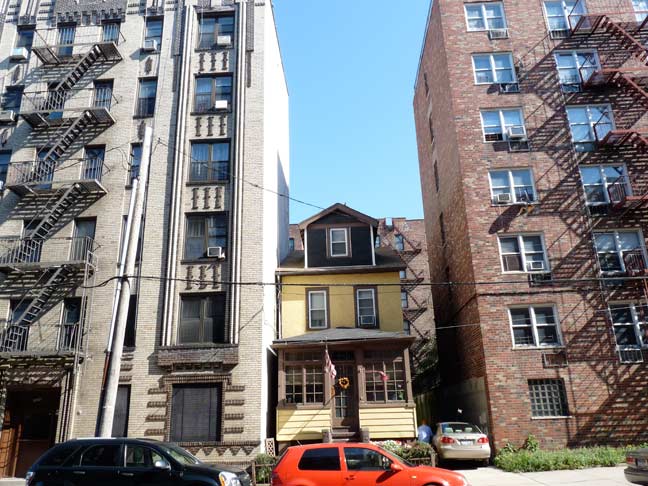The visuals for this activity were created by Eva and Jamie from Mr. Ford’s ICT 11 and 12 classes
The play, “Death of a Salesman,” written by Arthur Miller, depicts the modern American family found within the late 1940s. The play illustrates the emotional setting of the Loman’s house as a place of isolation as it is described to be wedged between apartment buildings that tower over their property; Willy discusses with his wife Linda how “there’s not a breath of fresh air in the neighbourhood [and how] they should’ve had a law against apartment houses” (Miller 17). The house itself gives Willy spikes of nostalgia, back to when he and his family lived in the house before the major reconstruction of his neighbourhood; Willy longs to grow a garden and play football with his children again, however, he feels trapped in his enclosed home deep in the city. The physical setting of the Loman’s house is located within Brooklyn, New York in the late 1940s; the era in which the play takes place is called the “Baby Boom” era when there had been a massive influx of babies being born after World War II had ended. Miller describes the physical setting with passion and embraces the mood of the storyline by using emotions to depict the physical characteristics of the set; at the beginning of the play the narrator indicates that “the surrounding area [of the Loman’s house] shows an angry glow of orange,” which is a description of the apartment buildings enclosing the Loman’s house, giving the reader an idea of how the story may follow up on the apartment buildings being portrayed (Miller 11). The emotional and physical setting of the Loman’s house within the play, “Death of a Salesman,” plays a big part in the characters and how they will interact with the setting throughout the play.
Quote #1:
“The kitchen at center seems actual enough, for there is a kitchen table with three chairs, and a refrigerator. But no other fixtures are seen” (Miller 11).
Quote #2:
“At the back of the kitchen there is a draped entrance, which leads to the living room” (Miller 11).
Quote #3:
“To the right of the kitchen, on a level raised two feet, is a bedroom furnished only with a brass bedstead and a straight chair” (Miller 11).
Quote #4:
“Behind the kitchen, on a level raised six and a half feet, is the boys’ bedroom, at present barely visible. Two beds are dimly seen, and at the back of the room a dormer window. (This bedroom is above the unseen living room.) At the left a stairway curves up to it from the kitchen” (Miller 11).
Quote #5:
“The entire setting is wholly, or, in some places, partially transparent. The roof-line of the house is one-dimensional…Before the house lies an apron, curving beyond the forestage into the orchestra” (Miller 11).
Quote #6:
“Biff gets out of bed, comes downstage a bit, and stands attentively” (Miller 19).
Quote #7:
“The gas heater begins to glow through the kitchen wall, near the stairs, a blue flame beneath red coils” (Miller 68).
Quote #8:
“Funny, Biff, y’know? Us sleeping in here again? The old beds. (He pats his bed affectionately.) All the talk that went across those two beds, huh? Our whole lives” (Miller 20).
Quote #9:
“Remember those two beautiful elm trees out there? When I and Biff hung the swing between them?” (Miller 17).
Quote #10:
“[Willy] unlocks the door, comes into the kitchen…He closes the door, then carries his cases out into the living-room, through the draped kitchen doorway” (Miller 12).
Brooklyn (Appearance Fact #1):
-The style of interior design was based on bright colours and fun patterns as the USA had a positive outlook on the future and post-war recovery. Emphasis on comfort and leisure as families were moving into the suburbs. It was a prosperous time for middle class families, big backyards and cozy homes grabbed the attention of young families.
Brooklyn (Appearance Fact #2):
–Brooklyn had helped to supply the industrial needs of the country, but by the 1950s, Brooklyn’s industrial energies began to diminish. Heavy manufacturers began to move to cheaper locations in other cities, and the ports became less active as large container ships, requiring deep harbours, began to dominate the shipping trade.
Brooklyn (Appearance Fact #3):
-High population (2.7 million) caused an influx in people to walk the streets of Brooklyn, making it a crowded and loud place to live in the 1950s
Brooklyn (Appearance Fact #4):
-Diverse, with a ton of Italian, Jewish, and Irish immigrants; population hit a high of 2.7 million by the 1950s. Immigrants were living the American dream.
Brooklyn (Appearance Fact #5):
–The Brooklyn Eagle was a newspaper found in Brooklyn, created in 1841 by the original name, The Brooklyn Eagle, and Kings County Democrat. This paper helped bring attention to Brooklyn from other boroughs in New York, as the paper was only distributed within Brooklyn. The paper was assisted by the National baseball league team, the Dodgers; both major institutions were lost in the 1950s: the paper closed in 1955 after unsuccessful attempts at a sale following a reporters’ strike, and the baseball team decamped for Los Angeles in a realignment of major league baseball in 1957.
https://images.app.goo.gl/GeyX975Ue9YGMzpk8

https://www.pinterest.ca/pin/74379831324007397/?lp=true
http://www.mikeettner.com/tag/death-of-a-salesman/

https://forgotten-ny.com/2012/01/where-am-i-10/




